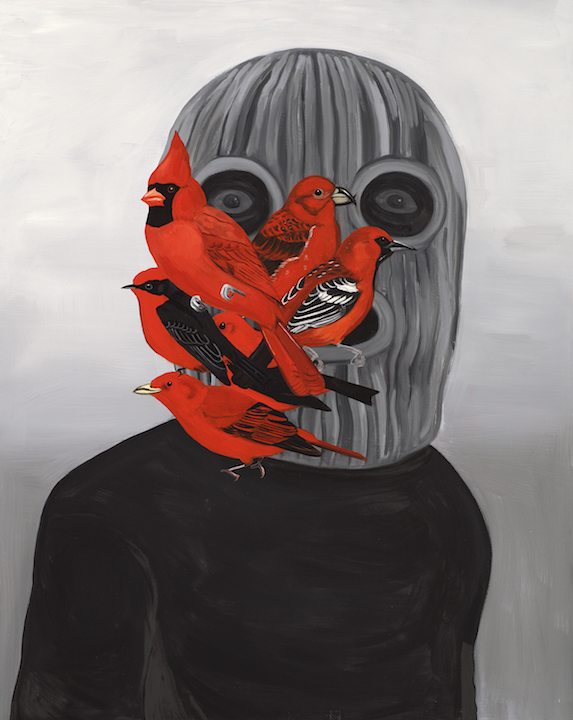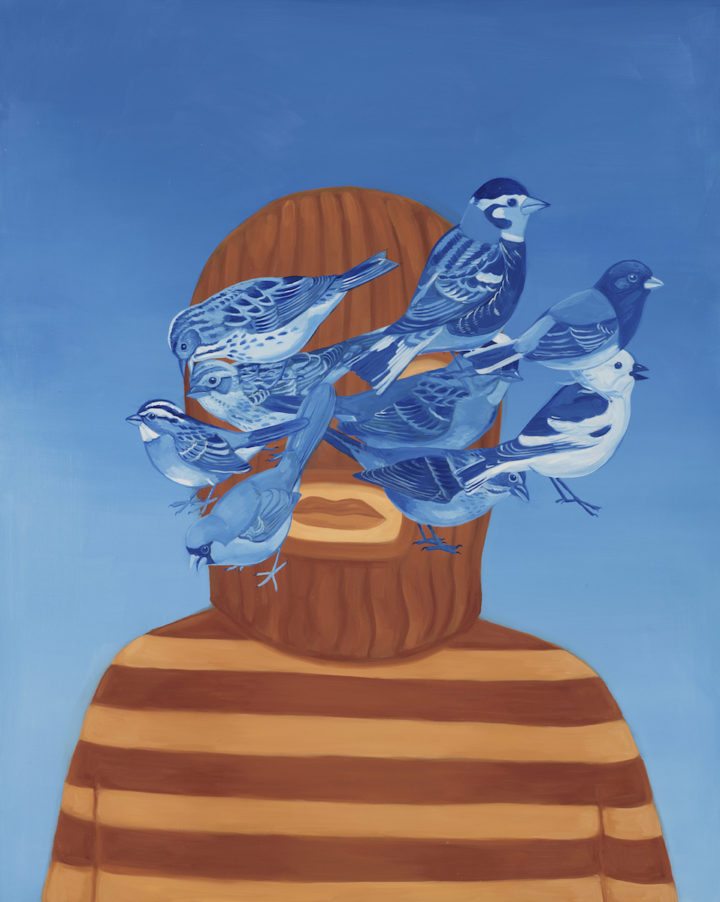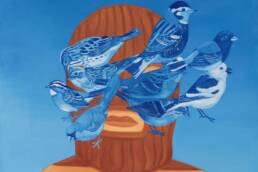The tumour was discovered. The surgery date set. Then the trip into a world of madness began. This is the story of one woman’s journey through psychosis, and the dear friends that hung on for the ride. By Emily Nilsen. Illustrations by Andrew Pommier.
The house in Prince Rupert, British Columbia, is cute and perfect. Sky blue with white trim and a rosy red door, it has an immaculate paint job that covers its ocean-weathered character. Elise, a former resident of the house, writes, “It was the kind of house that most people like us would like to live in.”
I stand on the sidewalk in front of the house using Google Street View. The date stamp is June 2012. A classic low-lying coastal fog hugs the hill behind the neighbourhood. Elise was 27 years old when she moved in, and by “people like us” she is referring to her roommates who were young, professional, active, outdoorsy and left leaning. The yard is kempt, lawn recently mowed into fresh stripes. Four globe-shaped cedar bushes and two hanging baskets by the front door accentuate the tidiness.

But the house’s orderly appearance was at odds with the inhabitants’ reality. One year before the Google photo was taken, Elise’s roommate, Laurel, was experiencing what she believed to be a kind of spiritual awakening. Six months later, at the age of 26, she was diagnosed with a choroid plexus papilloma, a non-malignant tumour located in the fourth ventricle of her brain. Shortly after diagnosis, and leading up to its surgical removal, Laurel slipped into a deep psychosis that Elise describes as, “one of the most stressful, anxiety-infused experiences of my entire life.”
Onset
Known for her organization, Elise began to document Laurel’s sudden behavioural change. The first journal entry, dated January 2012, opens with, “When do you decide where something started?”
By the time Elise had had become fully aware of Laurel’s atypical actions, the roommates had known about the brain tumour for almost a month. Red-flag moments were quickly stacking up. “It had snowed 120 centimetres at the ski hill,” Elise recalls. “Everyone was exhausted from skiing.” Meanwhile, despite having invited “like, 30 people” over for dinner, Laurel had gone to yoga and did not return. When Elise found her, she was sitting alone with the yoga instructor after having “some type of fit where she thought she was talking to God.” Elise took her home.
Laurel remembers the yoga class but doesn’t mention the dinner invitations. She remembers losing track of time, becoming privy to another dimension, being overcome with a floating sensation, then feeling her face disintegrate into itself, rolling over and over; it was a horrifying black hole that sucked her into an endless vacuum. When she opened her eyes, the yoga instructor was in the lotus position beside her. She felt like she had “passed the test.”

We are drinking tea in Nelson, British Columbia, when Laurel tells the yoga story. She now lives in the West Kootenay region where she researches amphibians. She is freckled, instantly likable and intelligent. When we first met, her strawberry-blonde hair was trimmed into a funky acorn-cap around her face. Her hair is now long. She hesitantly lifts it up to reveal the site of the tumour removal, a four-inch scar that vertically bridges her neck and skull.
Pre-diagnosis
According to the Canadian Mental Health Association, a person with psychosis “experiences some loss of contact with reality, characterized by changes in their way of thinking, believing, perceiving and/or behaving.” In other words, the fragile line that separates our perception of what is real and what is unreal becomes blurred. When we break our tibia, the x-ray shows the fracture line, a cast repairs the bone, and we eventually bear weight again. Unlike a broken bone or a torn ligament, there is less certainty when it comes to the brain. This vulnerable three-pound organ can shape and order, or disorder, reality.
It’s tricky for Laurel to dissect her experience and note the specific day or particular moment that constitutes the beginning. For over a year, before her tumour was discovered, various signs had been gathering momentum. Her renewed faith was one. Laurel was born into a strict Catholic family, but after high school her belief began to stray. By her early twenties she found religion to be illogical. “By 2010, I definitely did not believe in God,” she assures me, adding that she had watched the documentary Religulous that year, entertained by the ridiculous nature of religion. Fast forward one year: Laurel started to devour any and every kind of Catholic or New Age spiritual writing, such as Deepak Chopra or Andrew Harvey, and Brother Sun, Sister Moon, a 1970s film about St. Francis of Assisi.
She remembers losing track of time, becoming privy to another dimension, being overcome with a floating sensation, then feeling her face disintegrate into itself, rolling over and over; it was a horrifying black hole that sucked her into an endless vacuum.
Laurel had also begun to experience tactile hallucinations. Spiders ran down her arms; hot and cold liquid rippled throughout her spine. Some days, drab autumn colours pulsated brightly and the flight patterns of birds began to take on meaning. She was also blacking out. Laurel would feel a rush of heat followed by a bouncing sensation. When lying down, she had a very deep feeling that something was pulling her into the earth by her neck. “I felt as though I was beginning to have mild super-human powers,” she says somewhat abashedly.
Laurel was mostly keeping these insights to herself, a secret life that was subtly supported by obsessive readings and a relatively new Taoist yoga practice. When Laurel disclosed the sensations she was experiencing, the teacher assured her they were part of the practice, indicative of energetic release.
Internally, her sensations were becoming more intense, feeding into her amped-up thirst for religion and spirituality, which in turn offered an explanation to the otherwise strange goings-on. Externally, Laurel was highly functional. Her life was peppered with the types of things you would expect of any ambitious twenty-something: summer music festivals, ocean paddling with her boyfriend, forest walks, house renovations. Professionally, she worked full-time as the manager of the NDP’s Prince Rupert campaign office.
Laurel was in the office when one of the sensations pulled her neck back in a spasm, knocking her head against the wall as she fell to the floor. The rushes were happening almost 10 times a day: they felt weird, almost good. Laurel’s co-worker encouraged her to get checked out. The heart tests and blood work both turned up normal. When her brain activity was measured with electrodes, it too was fine. “I remember thinking the doctors were never going to find anything,” Laurel says. “I was convinced that what I was going through was totally spiritual.”
Diagnosis
Choroid plexus papillomas begin in the brain’s cerebrospinal fluid spaces and have a cauliflower-like appearance. These tumours can cause fluid to build up in the brain, which can then create pressure. Symptoms can include confusion, nausea or vomiting, personality changes, seizures, trouble speaking, vision changes and weakness or loss of sensation in the arms and legs. When an MRI confirmed this type of tumour was slowly growing in Laurel’s fourth ventricle, she began taking dexamethasone, a steroid to reduce swelling. Surgery was scheduled for April 2012, three months later. She took a leave of absence from work.
By now her appetite for religion was plentiful. She was throwing whatever money she had into astrology sessions, spiritual counselling, and religious books. Jesus had visited her on one of her visits to the hospital, his face a glowing white heat in the doorway. Shadows were shifting into evil shapes. On her way home from seeing the neurosurgeon at Vancouver General Hospital, the airport suddenly shifted into a matrix-like zone where undercover demons were hunting her. Despite the initial terror, Laurel was flying full force into what she describes as “an awesome, manic time, where life was amazing and I felt invincible.” Her inner narrative, no longer undercover, had finally spilled out into the world around her.
“I remember thinking the doctors were never going to find anything,” Laurel says. “I was convinced that what I was going through was totally spiritual.”
Laurel’s behaviour was instantly alarming to her roommates. After the yoga class incident, Elise sat Laurel down at the breakfast table and started asking her questions. “Her answers were unbelievable,” Elise says. “She mentioned hearing voices. I asked, ‘What would you do if the voices told you to walk into the ocean in the middle of the night by yourself?’ Laurel said she would do it and expects that it would feel pretty good.” Laurel also told Elise that the tumour had moved up and popped out the top of her head and that she felt crackling throughout her body. After breakfast, the roommates went for a walk. Laurel led them to a tree, put her hands on the bark, and started to talk to it.
Elise admits that in retrospect there might have been subtle signs leading up to the more obvious ones. She recalled the extreme fluctuations in Laurel’s energy levels, her non-stop stretching and tension release, and how Laurel would marvel over the beauty of smells Elise found repulsive. “She had started spending a lot of money too,” Elise says. Laurel had splurged on over $100 worth of fish from Dolly’s Fish Market when they already had a freezer full at home, and she was shopping for wedding gowns and suits online.
Psychosis
The details of Laurel’s psychosis begin to get blurry for her around the time of the yoga class incident. Trying to pinpoint the exact cause of her psychosis is like trying to untie a tight knot tangled up with genes, physiology, memory, anatomy, hormones, history, stress and society. Case studies of psychosis linking it to tumours, steroids and viruses have been chronicled in medical journals. For whatever interlocking reasons, Laurel found herself in a liminal land where the space between sanity and insanity had collapsed.
She remembers holding a strawberry, watching its seeds plump and perk up. She tried to hatch a dozen store-bought eggs, carrying them around in the pockets of her dress and storing a few in sheepskin slippers by the fire. “They cracked,” Laurel says. “It was really rank.” Elise wiped up a lot of yolk.
Laurel snipped off the plugs of all the household’s electrical appliances and put them into a bowl. She was convinced she could melt down the metal with her hands. Nature became an entity. She put on her slinky black dress and went on dates with the yard. Barefoot, even though it was winter, she churned up the garden bed with both hands, licking dew off the leaves. “I swear I could see the plants slowly growing little by little,” she says. Laurel argued to have the houseplants left outside, determined they would thrive in the winter air. Elise shares an entry from her journal, “Oh, the rubber tree,” she reads. “Laurel is still claiming it is alive and will grow two feet soon. It is now down to one leaf.”
“What am I? Am I the second coming? Yes! This is the end of the world and I am going to give birth to the new Jesus. Actually, it will be twins, a girl and a boy: Jesus and Sophia. Or, maybe I am a Greek Goddess.”
Psychiatrist Joel Gould believes “there is psychotic elements in all of our brains.” Interviewed on a CBC Ideas radio documentary called At Wits End, Gould shifts the idea that psychosis is a series of symptoms reserved for the patient, the other. “We actually can put ourselves in the place of someone who is suffering psychosis,” he says. “Dreams are essentially psychotic thought, it is the unconscious coming into your conscious mind, and you are asleep. People have hallucinations using certain kinds of hallucinogenic drugs. That is, in a sense, a psychotic symptom,” he explains.
Laurel cut her hair into what Elise referred to as “a typical crazy-lady style.” She boiled her locks on the stove and made potions for her roommates. “We had to pick our battles,” Elise says. “We drank the freaking potions, sat through the séances. We let her skip around outside with kosher salt and bathe in olive oil.” She laughs, then adds, “She was super greasy.”
Laurel’s brain was fast and sharp. She drew complex diagrams, confidently sharing insights while holding direct eye contact. She argued with a clarity and conviction she had never felt before. She toiled over her identity, wondering, “What am I? Am I the second coming? Yes! This is the end of the world and I am going to give birth to the new Jesus. Actually, it will be twins, a girl and a boy: Jesus and Sophia. Or, maybe I am a Greek Goddess.”
Pre-Surgery
Leading up to the April surgery, the roommates took time off from their professions to supervise Laurel. “We couldn’t leave her alone,” Elise says. “She was a danger to herself, and she could have burnt the house down.” Laurel’s manic creativity, while at times funny, was more terrifying now than entertaining to the roommates who were completely ill-equipped to deal with their once very capable friend. “We were young,” she says. “None of us had personal experience with mental-health issues.”
Laurel couldn’t see a psychiatrist without a referral. She couldn’t see the family doctor to get the referral without going to the clinic. At this point, Laurel insisted she would die if she left the house and the doctor refused to come to the house or give the referral over the phone. “We were essentially prisoners in our home,” explains Elise. With the help of friends, they were eventually able to navigate the medical system and bring a youth counsellor to their home.
At a truck stop she kneeled to wash the paint off with old snow, rubbing colours around, trying to remove the paint. Her face was raw, smeared in purple. It was a few days before surgery: she was certain they would find nothing.
The heart of Laurel’s psychosis lasted just over a month. As soon as she began taking anti-psychotic medication, she was able to sleep. A side effect of the drugs made her lactate and, as Laurel puts it, “they put a real damper on things.” Although she had the same thoughts, desires and impulses, she lacked the energy to carry them out. She prayed a lot. “It was the calm version of crazy Laurel,” Elise says, “but we didn’t have her back yet.”
In the days before the surgery, Laurel knew she had a tumour and believed she could heal it. For months she had been compulsively touching her neck, confident that when the surgeon cut her open the tumour would be gone. Everyone would marvel at her healing prowess. On the drive to Vancouver, Laurel used watercolour pencil crayons to paint her face into who she thought she was. “It was purple and weird,” she says.
Post-Surgery
Laurel woke in the ICU with an insane thirst. Nurses sponged small amounts of water into her mouth. She fell back asleep and then awoke, relieved to hear surgery had gone well. Visitors came and went. She was sore and nauseous. Her recovery was totally normal. She felt blah and zombie-like, and the thought of being able to heal the tumour was now an abstract idea, somehow no longer relevant.
By the time Elise had had become fully aware of Laurel’s atypical actions, the roommates had known about the brain tumour for almost a month.
Although Laurel’s delusions had subsided, by the time she returned to Prince Rupert, she had dropped into a serious depression. She would walk into the forest hoping that wolves would come and eat her. She felt “like a worm” and describes an unsettling sense of worthlessness, a sticky kind of darkness only those who know can know. The depression lasted months.
At a truck stop she kneeled to wash the paint off with old snow, rubbing colours around, trying to remove the paint. Her face was raw, smeared in purple. It was a few days before surgery: she was certain they would find nothing.
Scar Tissue
To pinpoint the absolute end of Laurel’s psychological state is almost as hard as narrowing in on its molecular beginning. After Laurel’s up, and subsequent long down, a welcomed levelling followed, spurred on by routine and distance in time and space. Laurel moved to a new town, started a new job and, eventually, a new life unfurled. It has now been over five years and she has had zero flickers of relapse. Her anxiety around the mind’s fragility has also waned. The scar on her neck is straight as an arrow pointing north.
Shortly after Laurel had returned from the hospital, Elise remembers scanning her friend’s behaviour, anxiously looking for signs that Laurel was reflecting on her experience and could acknowledge that she had gone off the rails. Written just weeks after surgery, her last journal entry reads, “Laurel looked at the infamous rubber tree and said, ‘That poor rubber tree. I can only hope for a miracle now, but I sure was convinced it was going to grow.’”
While researching this story, Nelson-based writer Emily Nilsen gained insight into the fragility of the human brain, and renewed her respect for those suffering from shifting mental states. By request of the people featured in her piece, the names used are pseudonyms.
Emily Nilsen
Emily Nilsen is a Nelson-based writer originally from Vancouver. Her work has been translated into Norwegian and Spanish and published in literary journals, magazines, and newspapers.
Related Stories
Into The Mind
From the makers of All.I.Can comes the new feature film: INTO THE MIND intothemindmovie.com facebook.com/sherpascinema…
Facts You Never Knew About Mt Baldy
As the world gets busier, people move faster and the memory of "the good ‘ol days" seems to slip away, it's good to…
The Craziest Rope Swing in The World
Oh. My. God. This is absolutely terrifying. The look on their faces tells you just how terrifying it must have…
2012 Freeskiing and Freeride World Tour
2012 Freeskiing and Freeride World Tour was in Revelstoke BC on Jan 4-11. Mens Results, -Canadian Kye Petersen took…
Mount Carlyle KMC Trip, January 2013
KMC Editor-in-Chief Mitchell Scott and contributing photographer Dave Heath recently spent a week at Mount Carlyle…







